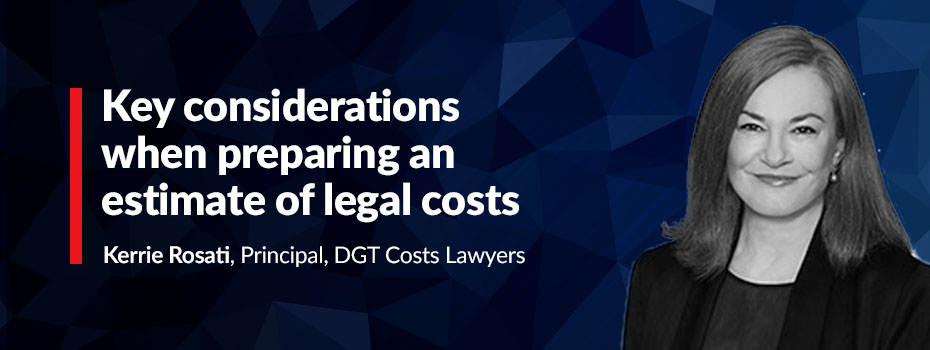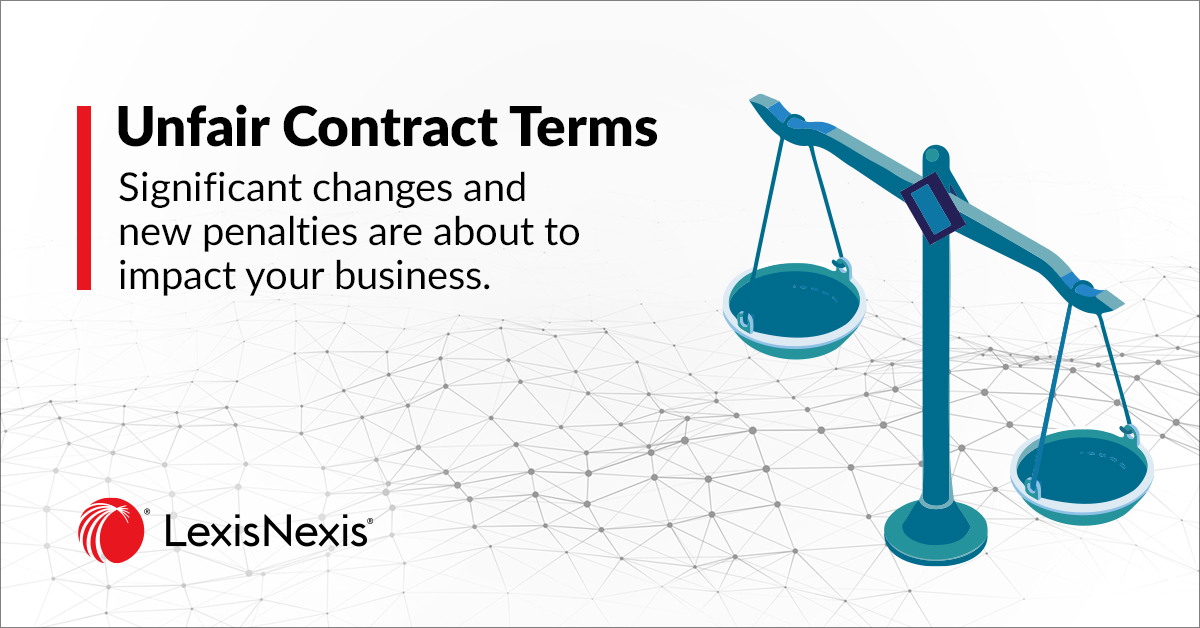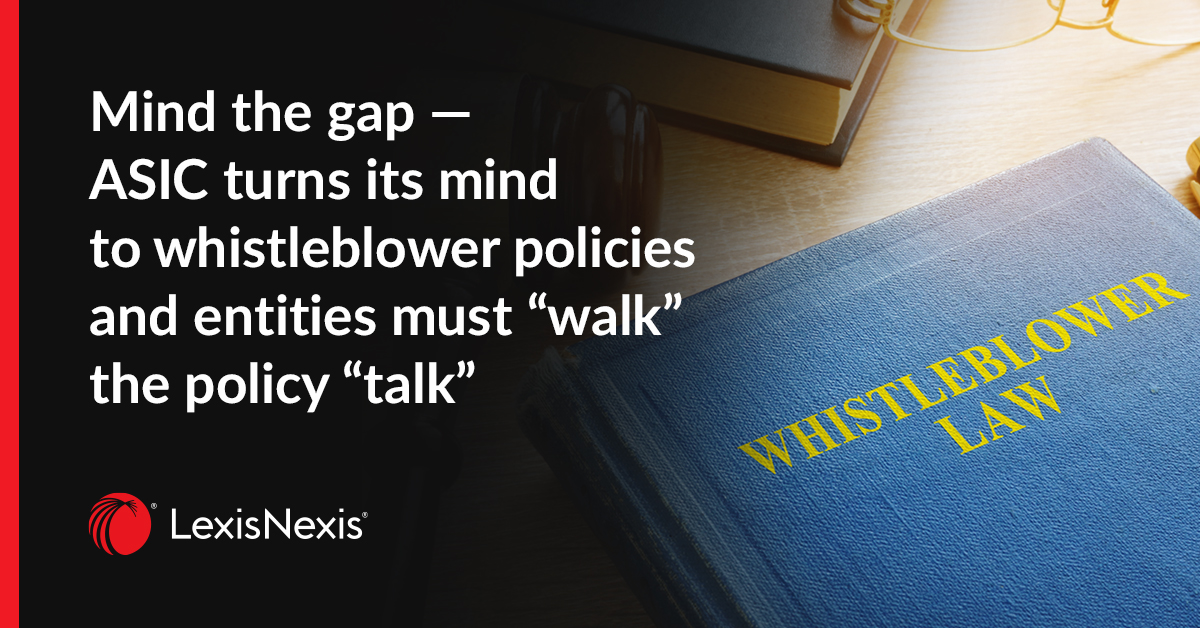
Key considerations when preparing an estimate of legal costs
09 September 2022 14:02
Kerrie Rosati, Principal, DGT Costs Lawyers
This article sets out several key considerations for legal practitioners, barristers and litigators when preparing a cost estimate, and addresses the following questions.
- Why is providing an estimate of legal costs important?
- How should you draft the costs estimate, and should you provide single figure estimates or estimates in within a range?
- In litigious matters, how do you estimate the recovery from other parties or the payment of legal costs to other parties?
- What types of claims in certain jurisdictions are subject to costs caps or limitations on the recovery of costs from other parties?
- What disclosures should be made in Uniform Law jurisdictions?
- How should you finalise a costs estimate to ensure understanding and consent?
Why is providing an estimate of legal costs important?
Legal practitioners often have a distaste or disinterest in discussing or estimating fees with their clients.
A high estimate may cause a client anxiety and may result in work being lost, but on the other hand, a low estimate may quickly be exceeded (and require updating), which can cause “bill shock” for a client and impact upon the client’s trust in the law practice.
Nevertheless, it is critical for legal practitioners to ensure that the estimate of total legal costs is as accurate and thorough as possible.
Legal practitioners in all jurisdictions are required to disclose information in relation to legal costs to a client as soon as practicable upon taking instructions from the client.
While there are many matters that must be disclosed (including the basis upon which costs will be charged), one of the critical matters that a practitioner must disclose to a client is an estimate of the client’s total legal costs (including disbursements and goods and services tax, i.e. GST).
Accordingly, proper and considered costs estimates are not only important from a compliance perspective, but also a key element in managing and cultivating the lawyer-client relationship.
What are the benefits of providing costs estimates?
Practitioners who take the time to carefully consider their costs estimates and cultivate their skills in estimating costs are likely to realise some significant benefits for both their practice and their client, such as:
- More effective project management — preparing an estimate requires the work to be broken down into its component stages, which invites a considered and thoughtful analysis of the matter. This assists practitioners in managing the project, allocating resources and advising the client.
- Improved prospects of payment — a client who is provided with an accurate estimate is far more likely to manage their resources and budget, which often results in timely payment of invoices. Clients who suffer from “bill shock” are more likely to withhold or delay payment, whether due to their concerns about the amount of an invoice or their inability to pay an invoice that is more than they anticipated.
- Improved client relationships — a practitioner who knows how to provide an accurate estimate of legal costs may demonstrate to a client that they are experienced and honest.
What are the initial considerations when preparing an estimate of costs?
When preparing costs estimates, practitioners should consider the following questions:
- Who is the client? Are they a sophisticated client or a government or commercial client who may be excluded from certain disclosure requirements?
- How does the law practice intend to charge for their services in relation to the matter?
- What is the client’s objective? What are the options for achieving that objective? Which option(s) does the client wish to pursue?
- In relation to the option(s) that the client has instructed the law practice to pursue:
- What are the steps involved? Will the matter involve interlocutory or pre-litigation applications? Is there a risk that the matter will be delayed or become more complex or larger in scope?
- What are the likely costs (including disbursements) associated with the option(s)?
- Are there variables or risks that may significantly impact upon the costs in the matter? An example of this is where a court proceeding involves a party who resides in another jurisdiction, or where that party has not engaged legal representatives to act on their behalf. It may also be relevant to assess the attitude of the other party and their lawyers to the matter — it is sometimes the case that a practitioner knows that another law practice is more likely to engage in interlocutory skirmishes and adopt a combative attitude towards a dispute, which may result in increased costs.
- What are the likely avenues for resolution of the matter (ie negotiated outcome or contested judicial determination)?
- What costs has the law practice incurred in acting in similar matters in the past? Modern billing systems allows practitioners to easily review total legal costs actually incurred in historical matters, and this data should be leveraged.
- How will the law practice allocate resources to the matter — who will do the work and at what rates?
- Will it be necessary to brief counsel or expert witnesses? What are the likely disbursements?
- Who is paying the bills? If it is not the client, then consider the disclosure requirements that apply to third party payers.
How should you draft the costs estimate?
Once these matters have been considered (and instructions sought from the client), it is often helpful to break a matter up into stages using a table and calculate the likely costs for each stage of the work.
Preparing a table is also helpful in defining, with precision, the scope of work contemplated by the costs agreement. Often, confirming a client’s instructions (and the scope of work) in a costs agreement can be done with reference to the table. For example:
We confirm that you have instructed us to act on your behalf in [describe the proceeding] including but not limited to the steps contemplated by our table of estimated costs set out below.
Practitioners may find it useful to refer to the Precedent — Table for estimating costs in litigious matters inside Practical Guidance Dispute Resolution. This table provides a framework for estimating costs in relation to the stages of litigation and may assist practitioners in remembering to include critical disbursements such as counsel fees, setting down fees and daily trial fees.
Setting out the work and costs involved in a matter in stages has the benefit of:
- informing the client about the legal process — this is especially true in litigation, where a client may not always understand what is involved in bringing a matter to trial; and
- establishing a framework for raising and disclosing risk factors, complications and non-standard items (eg the prospect of a defendant making an application for security for costs, potential interlocutory applications, the prospect of an early settlement at mediation, etc).
When charging on an hourly basis, law practices should work out the time to be spent by each fee earner on each stage (ensuring that allowances have been made for contingencies). In a separate column, practitioners should calculate the estimate for disbursements associated with each stage.
Single figure estimates vs estimates in the form of a range
Where the Uniform Law applies (currently, New South Wales, Victoria and Western Australia), the law practice must express the estimate as a single figure estimate of total legal costs.
This may be expressed using words to the following effect: “Your fees and expenses to be incurred with us in carrying out your instructions are estimated to be [single figure] (inclusive of GST)”.
However, where the Legal Profession Legislation applies and it is not practicable to provide a single figure estimate, the law practice may provide an estimate in the form of a range of costs (lower and upper) together with an explanation of the major variables that will affect the calculation of the costs.
This may be expressed using words to the following effect: “It is not possible at this time to provide an accurate estimate of the total costs. We advise that we believe legal costs will fall within the following range: $ [lower estimate] to $ [upper estimate] (inclusive of GST). The major variables that will affect the calculation of these costs are [set out the factors that inform the spread between the lower and upper estimates].”
The estimate should be presented to the client in a format that they can understand. For some clients, it will be appropriate to simply provide an estimate of total legal costs that applies with respect to the scope of work described in the costs agreement. For other clients, it will be more appropriate to provide that estimate together with a table that breaks down that estimate into parts that support the calculation of the estimate.
Estimating the recovery from other parties or payment of legal costs to other parties in litigious matters
In jurisdictions where the Legal Profession Legislation applies, practitioners are obliged to disclose the following information in litigious matters:
- an estimate of the range of costs that may be recovered if the client is successful in the litigation; and
- an estimate of the range of costs the client may be ordered to pay if the client is unsuccessful.
Law practices should also disclose the following matters in relation to the issue of costs that may arise in litigation matters, namely that:
- The court may order the client to pay other moneys, including some or all of the costs of other parties.
- The client’s costs owed to the law practice are payable by the client according to their payment terms irrespective of whether the client may, if successful in its action, have rights to recover some of its costs from another party or parties.
- The scale of fees that applies in the court in which the litigation is commenced will usually determine what can be recovered from the other party if the client is successful.
- Even if the client is successful in obtaining an order for payment of its costs, payable by another party:
- that order will not necessarily cover the whole of the client’s legal costs; and
- the costs order is likely to be for an amount substantially less than the actual costs payable to the law practice — the law practice should set out the percentage of their actual incurred costs that the client is likely to recover (say, 55–60% of actual costs on a party and party basis) and confirm that the client is still obligated to meet the difference in these costs from its own pocket.
- If the client is unsuccessful, it may be liable to pay the costs of other parties to the litigation in addition to the law practice’s costs. Law practices may use words to the following effect: “As we are not aware of the extent of the legal work which may be performed for the other side, it is difficult to be precise as to what the amount of such costs might be. We would estimate these may be between [insert percentage] % to [insert percentage] % of the amount of your own legal costs, namely $ [insert total estimate of legal costs]”.
- Particular types of claims in certain jurisdictions are subject to costs caps or limitations on the recovery of costs from other parties. For example, the amount of costs recoverable in the Small Claims Division of the New South Wales Local Court is limited in certain circumstances (see NSW Local Court — Costs in the Small Claims Division), as are costs in personal injury claims and claims under the Motor Accidents Compensation Act 1999 (NSW) in the New South Wales District Court (see NSW District Court — Costs orders and costs assessments).
While the above only applies under the Legal Profession Legislation, practitioners in Uniform Law jurisdictions are strongly encouraged to make disclosure of these matters insofar as the explain the difference between party/party costs and costs actually incurred (it is not advisable to provide numeric estimates).
Finalising a costs estimate and ensuring understanding and consent
Law practices are obligated to take all reasonable steps to be satisfied that clients understand and have given consent to:
- the proposed course of action in a matter; and
- the costs associated with that proposed course of action.
Accordingly, after preparing a costs estimate, practitioners should take the time to discuss the estimate of total legal costs for any proposed courses of action with their client and ensure that the client consents to and understands the proposed course of action and the likely costs involved.
This is often done by asking the client to explain, in their own words, their understanding of the proposed course of action and the costs involved. Their response can then be recorded on the file. It is prudent to subsequently confirm the client’s instructions in writing.
Updating costs disclosure
When a client signs a costs agreement, practitioners should diarise the estimate of total legal costs and keep track of how costs are progressing as compared to the estimate.
In the event of any significant change to anything disclosed to a client, including changes to any of the following items, these changes must be disclosed to the client, in writing as soon as the law practice become aware of the change.
- the rates of charge;
- the fee earners working on the matter; or
- the estimate of total legal costs.
It is critical for law practices to monitor costs against their estimates because costs disclosure must be prospective, meaning that a law practice must inform the client of any change to an estimate before any additional costs are incurred.
In litigious matters, it can be helpful to provide updates about costs at the time of rendering an invoice. Consider providing clients with an update as to the progress of the litigation and a summary of how the law practice’s costs are tracking against the estimate.
Further Reading inside Practical Guidance Dispute Resolution (subscription required)
For a general overview of the statutory framework that regulates costs between law practices and clients across Australia, including under the Legal Profession Uniform Law (Uniform Law) and the Legal Profession Acts that apply in states and territories other than New South Wales, Victoria and Western Australia (Legal Profession Legislation), refer to Costs between lawyers and clients — the statutory framework (a LexisNexis subscription may be required).
The following guidance notes and precedents written by the LexisNexis Legal Writer team, and much more, can be found inside Practical Guidance Dispute Resolution.
- A summary of alternative fee arrangements.
- Costs disclosure — requirements, exceptions and consequences of non-compliance .
- Table for estimating costs in litigious matters
- Letter to client providing updated costs disclosure
Publicly Available Resources
- Federal Court — Costs;
- Federal Circuit and Family Court (Division 2) — Costs;
- NSW Supreme Court — Costs;
- NSW District Court — Costs;
- NSW Local Court — Costs;
- Vic — Supreme Court — Costs;
- Vic — County Court — Costs;
- Vic — Magistrates’ Court — Costs;
- Qld — Supreme Court — Costs;
- Qld — District Court — Costs; and
- Qld — Magistrates Court — Costs.
- ACT Law Society — Costs Agreements
- Law Society of NSW — Costs
- Law Society of NSW — Fact Sheet — Costs Disclosure Under the Legal Profession Uniform Law
- Law Society of Northern Territory — Costs agreements and information
- Law Society of South Australia — Standard Precedent Cost Agreements
- Law Society of Western Australia — Costs
- Legal Services Council — Costs disclosure, costs agreements and billing
- Legal Services Council — Costs disclosure forms
- Legal Services Council — Legal Profession Uniform Law
- Queensland Law Society — Cost Disclosure Checklists
- Queensland Law Society — Costs FAQS
- Victorian Legal Services Board — Legal Costs
About Practical Guidance Dispute Resolution
Practical Guidance Dispute Resolution provides best practice on litigation processes, covering civil procedure in Australian federal and state courts & tribunals.
Supported by on-point cases, legislation, checklists, precedents and trusted LexisNexis deep research materials, this module enables practitioners to focus on the strategic aspects of any litigious matter.
Written by leading experts in private practice and the Bar across Australia, Practical Guidance Dispute Resolution is the definitive workflow resource for litigation practitioners.
Contact our Experts now for more information and FREE DEMO
Latest Articles
-
 3 tips for banking and finance lawyers when responding to an ASIC enquiry, and how to avoid misleading or deceptive conduct.
3 tips for banking and finance lawyers when responding to an ASIC enquiry, and how to avoid misleading or deceptive conduct. -
 Significant increases to competition and consumer law penalties have commenced and sweeping reforms to the unfair contract terms regime will follow in 12 months’ time.
Significant increases to competition and consumer law penalties have commenced and sweeping reforms to the unfair contract terms regime will follow in 12 months’ time. -
 The Australian Securities and Investments Commission (ASIC) is calling on Australian CEOs, from public companies, large proprietary companies and corporate superannuation trustees to review their whistleblower policies and processes to ensure compliance with private sector whistleblower laws.
The Australian Securities and Investments Commission (ASIC) is calling on Australian CEOs, from public companies, large proprietary companies and corporate superannuation trustees to review their whistleblower policies and processes to ensure compliance with private sector whistleblower laws.
Practical Guidance
Your one-stop solution for accurate legal answers from Australian legal experts. Tools, practically focused guidance notes, checklists, precedents, and training materials support and streamline your legal workflow.
LEARN MORE LexisNexis
LexisNexis